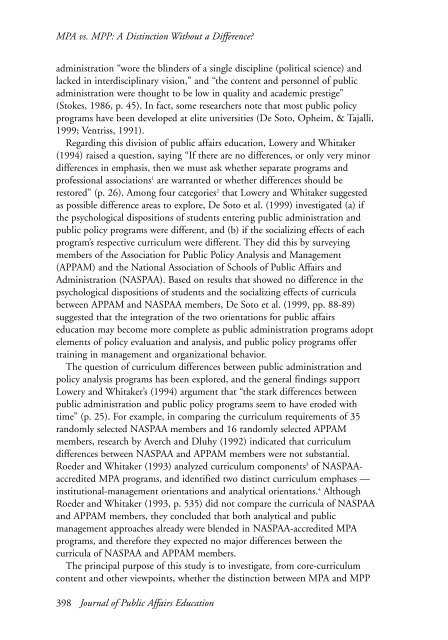JOURNAL OF PUBLIC AFFAIRS EDUCATION - National ...
JOURNAL OF PUBLIC AFFAIRS EDUCATION - National ...
JOURNAL OF PUBLIC AFFAIRS EDUCATION - National ...
You also want an ePaper? Increase the reach of your titles
YUMPU automatically turns print PDFs into web optimized ePapers that Google loves.
MPA vs. MPP: A Distinction Without a Difference?<br />
administration “wore the blinders of a single discipline (political science) and<br />
lacked in interdisciplinary vision,” and “the content and personnel of public<br />
administration were thought to be low in quality and academic prestige”<br />
(Stokes, 1986, p. 45). In fact, some researchers note that most public policy<br />
programs have been developed at elite universities (De Soto, Opheim, & Tajalli,<br />
1999; Ventriss, 1991).<br />
Regarding this division of public affairs education, Lowery and Whitaker<br />
(1994) raised a question, saying “If there are no differences, or only very minor<br />
differences in emphasis, then we must ask whether separate programs and<br />
professional associations 1 are warranted or whether differences should be<br />
restored” (p. 26). Among four categories 2 that Lowery and Whitaker suggested<br />
as possible difference areas to explore, De Soto et al. (1999) investigated (a) if<br />
the psychological dispositions of students entering public administration and<br />
public policy programs were different, and (b) if the socializing effects of each<br />
program’s respective curriculum were different. They did this by surveying<br />
members of the Association for Public Policy Analysis and Management<br />
(APPAM) and the <strong>National</strong> Association of Schools of Public Affairs and<br />
Administration (NASPAA). Based on results that showed no difference in the<br />
psychological dispositions of students and the socializing effects of curricula<br />
between APPAM and NASPAA members, De Soto et al. (1999, pp. 88-89)<br />
suggested that the integration of the two orientations for public affairs<br />
education may become more complete as public administration programs adopt<br />
elements of policy evaluation and analysis, and public policy programs offer<br />
training in management and organizational behavior.<br />
The question of curriculum differences between public administration and<br />
policy analysis programs has been explored, and the general findings support<br />
Lowery and Whitaker’s (1994) argument that “the stark differences between<br />
public administration and public policy programs seem to have eroded with<br />
time” (p. 25). For example, in comparing the curriculum requirements of 35<br />
randomly selected NASPAA members and 16 randomly selected APPAM<br />
members, research by Averch and Dluhy (1992) indicated that curriculum<br />
differences between NASPAA and APPAM members were not substantial.<br />
Roeder and Whitaker (1993) analyzed curriculum components 3 of NASPAAaccredited<br />
MPA programs, and identified two distinct curriculum emphases —<br />
institutional-management orientations and analytical orientations. 4 Although<br />
Roeder and Whitaker (1993, p. 535) did not compare the curricula of NASPAA<br />
and APPAM members, they concluded that both analytical and public<br />
management approaches already were blended in NASPAA-accredited MPA<br />
programs, and therefore they expected no major differences between the<br />
curricula of NASPAA and APPAM members.<br />
The principal purpose of this study is to investigate, from core-curriculum<br />
content and other viewpoints, whether the distinction between MPA and MPP<br />
398 Journal of Public Affairs Education

















